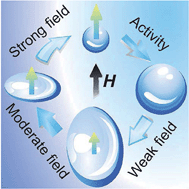Swim stress, motion, and deformation of active matter: effect of an external field
Abstract
We analyze the stress, dispersion, and average swimming speed of self-propelled particles subjected to an external field that affects their orientation and speed. The swimming trajectory is governed by a competition between the orienting influence (i.e., taxis) associated with the external (e.g., magnetic, gravitational, thermal, nutrient concentration) field versus the effects that randomize the particle orientations (e.g., rotary Brownian motion and/or an intrinsic tumbling mechanism like the flagella of bacteria). The swimmers' motion is characterized by a mean drift velocity and an effective translational diffusivity that becomes anisotropic in the presence of the orienting field. Since the diffusivity yields information about the micromechanical stress, the anisotropy generated by the external field creates a normal stress difference in the recently developed “swim stress” tensor [Takatori, Yan, and Brady, Phys. Rev. Lett., 2014]. This property can be exploited in the design of soft, compressible materials in which their size, shape, and motion can be manipulated and tuned by loading the material with active swimmers. Since the swimmers exert different normal stresses in different directions, the material can compress/expand, elongate, and translate depending on the external field strength. Such an active system can be used as nano/micromechanical devices and motors. Analytical solutions are corroborated by Brownian dynamics simulations.


 Please wait while we load your content...
Please wait while we load your content...